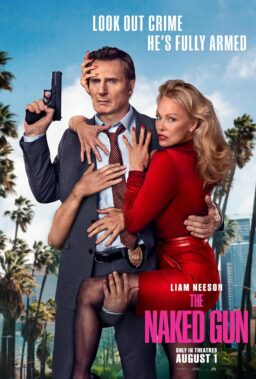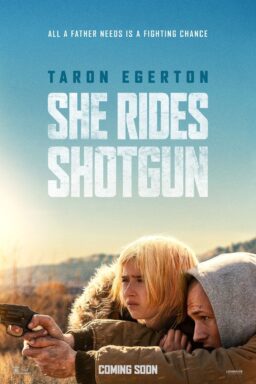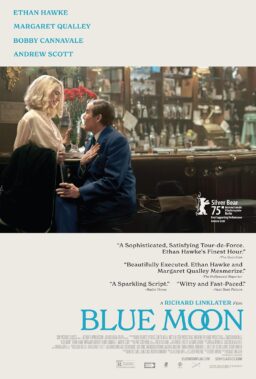Whenever a festival like Sundance appears on the calendar, the major features and documentaries take up much of the oxygen. And for good reason. However, short films are often skimmed past on the way to other brighter and shinier titles with either established or soon-to-be big Hollywood names.
It’s a difficult habit to break, one I’ve been especially guilty of. However, for this year’s Sundance I wanted to visit the varied and rich shorts programs the festival has to offer. In fact, Sundance has 74 live action, animated, and documentary shorts in multiple languages, starring or directed by men, women, and non-binary filmmakers. To these ends, I watched an assemblage of the shorts programs and chose the eight films that most resonated with me in a best of the fest rundown.

“Arabian Alien” (Meshal Aljaser)
Aliens are in Saudi Arabia, both literally and metaphorically, in Meshal Aljaser’s “Arabian Alien.” Filmed in black and white, Aljaser’s experimental film initially confounds. Saad (Abu Swaleh), the short’s protagonist, is a married man. With his wife, they see aliens carrying bananas arrested on television. The news pleads for anyone to report the same lascivious behavior if they see it.
“Arabian Alien” features gorgeous black and white shots of mosques and Saad’s home, often employing time lapses for impressionistic displays of otherness. The film’s poignant end makes a martyr out of love, and considering the concept, results in a surprisingly powerful political statement.

“Church and the Fourth Estate” (Brian Knappenberger)
Down in the sleeping town of Idaho Falls, Idaho, the Mormon Church reigns supreme. Decades ago in the community, Adam Steed, a child in the Boy Scouts and Mormon Church, was molested and raped by his scout leader Brad Stowell. It would take until Peter Zuckerman and Dean Miller of the Idaho Falls Post Register, and other journalists, to reveal his story and the depths of the abuse imposed in the Boy Scouts. Brian Knappenberger’s “The Church and the Fourth Estate,” like Tom McCarthy’s “Spotlight,” demonstrates the power of journalism to investigate and restore truth—even in the face of great opposition.
The real-life events, at times, play like a movie. There’s church leadership like Kim Hansen or the courts, who covered up and removed case files. The locals turn against their local paper, and journalists like Zuckerman are despised for their sexual orientation. Moreover, the paper and its journalists are attacked by the richest man in town Frank Vandersloot. Nevertheless, “The Fourth Estate””s most harrowing portions involve statements from Steed and another victim. They describe in unflinching detail the abuse suffered. And through tears and crushed memories, they recount the moment their childhood disintegrated. Their struggle for the truth is an act of bravery, while Knappenberger’s “The Church and the Fourth Estate” is a stunning and moving documentation of their courage.

“The Devil’s Harmony” (Dylan Holmes Williams)
Dylan Holmes Williams’ “The Devil’s Harmony” has a fantastic concept. Set in a London boarding school, a mysterious illness has affected the school’s jocks. They’re collapsing into comas in the lunchroom, hallways, and squash courts. On the other hand, there’s Kiera (Patsy Ferran). Routinely bullied, she runs an a capella group. And like the sirens of yore, she’s taught them how to harmonize in a way that puts victims to sleep in an act of revenge, one note at a time. Unfortunately for Kiera, she has a crush on the enemy, a squash player named Connor (Leo Suter). He wants to join the a capella group and cease from sports.
Williams’ “The Devil’s Harmony” is a throwback to ’70s sci-fi and “Children of the Corn”-type horror. It’s also hilarious. Through Williams’ simple yet unique execution, he relies on bird’s eye-view shots to summarize the scale of the a capella group’s attack. And at one point, the director blurs the lines between fantasy and musical, when Connor breaks out in song. Eerie and creepy, “The Devil’s Harmony” is pure brilliance.

“Hudson Geese” (Bernardo Britto)
On Jan. 15, 2009, Capt. Chesley “Sully” Sullenberger performed a miracle by improvising an emergency landing on the Hudson Bay that saved countless lives. But Bernardo Britto’s animated short “Hudson Geese” isn’t about the unbelievable event per se. Instead, he provides the voice and depicts a goose on its final migration.
Running over the span of six minutes, Britto personifies the bird in voiceover form: First, by introducing how the goose met his wife Sandra, then through relating their yearly migrations as vacations. The goose doesn’t understand our fixation in creating metropolitan areas, he poses humans as villains who create concrete jungles with few green spaces and less places for him and his wife to land. We soon view the snarky bird as a living breathing being with hopes and loves. And to a point, the only hilarity arrives in the sentiment that a goose might have feelings as deep as ours. This empathetic introduction lays the groundwork for the film’s eventually shocking turn, and Britto morphs a heroic human event into a tragedy in this witty animated short.

“John Was Trying to Contact Aliens” (Matthew Killip)
John Shepherd has spent 30 years trying to contact extraterrestrial lifeforms. In fact, if you visited his home during the ’80s, you’d find a living room closer to a science fiction movie set: packed with computers and panels adorned with millions of knobs and screens displaying electromagnetic waves—than a rural enclave. Matthew Killip’s documentary short “John Was Trying to Contact Aliens” is at once a story about a cosmically impossible dream, and a humanistic desire for companionship.
Initially, John is an eccentric figure. With long grey hair and a frazzled beard, his congenial smile and passion for searching for aliens belies his real-world struggles. An outsider, an abandoned soul, his unassuming personality seeps into an adorable disposition. John, who has spent decades transmitting everything from Kraftwerk to Reggae into space as an interstellar DJ, founded the S.T.R.A.T. program. While he introduces every song with his gentle voice, “Trying to Contact Aliens’” bip-bop synth score entrances the macro significance John attaches to the universe.
And when it seems as though Killip has forgotten the micro significance of the human experience, he connects the two in a heartening metaphor that brought me to tears. Because sure, John is peculiar, but his search through the universe mirrors our own intimate exploration for love. And his all-too relatable story isn’t alien, it’s the human condition. It’s the want to be accepted for who you are, and what you do, just as much as what anyone sees on the outside. It’s the empathy you find in isolation. Killip’s “John Was Trying to Contact Aliens” is a beautiful and inspiring story—from the soul and to the stars.

“Meats” (Ashley Williams)
Taking place at the back of a butcher shop, Ashley Williams’ satire “Meats” opens with a close-up of Williams crying. While tears stream down her cheeks, an ambivalent but kindly butcher (Giancarlo Sbarbaro) stares at her distress. Lately, Williams has been craving meat. In fact, recently on Thanksgiving she vacuumed a turkey by herself. The problem? She’s actually vegan and pregnant, and her fetus craves meat. During the film’s ten minutes, she recounts the multiple ways she feels guilty for consuming any animal, all while staring at the carcass of a dead lamb.
In an effort to calm her fears, the butcher and her carve the lamb down to the barest essentials. During these lighthearted scenes, Sbarbaro and Williams irreverently play off each other. And by film’s end, after the meat has been sliced, and trauma quieted, Williams at once vocalizes the disdain vegans share against consuming meat and the pleasure of partaking in the carnal practice every once in a while.

“Pillars” (Haley Elizabeth Anderson)
Amber is a soft spoken daddy’s girl; she’s also the protagonist of Haley Elizabeth Anderson’s “Pillars.” “Pillars” sees Amber as a tom boy. In the film’s opening images, she’s fishing and practicing boxing with her father. Part of a highly religious family, on this day, she attends church.
While at church, she spots a boy who likes her. She wants to kiss him, but she’s never done so herself. Furthermore, another girl at church sees her dilemma, and in the bathroom they practice kissing.
In Exodus, the Pillar of Fire is God providing guidance through the long journey. Anderson shoots this adolescent awakening in poetic fashion, relying on evocative handhelds. Moreover, during the kissing scene she chooses to employ extreme closeups of each girl’s facial features: eyes, nose, and lips. The result demonstrates their innocence. To these girls, they’ve done nothing wrong. Nevertheless, to Amber’s highly religious parents, she’s committed a sin and is disciplined for it. By film’s end, Amber finds that pillar, and a divine acceptance of her attractions.
Anderson’s impressionistic form captures comparisons to Terrence Malick, while the subject matter reminds one of Dee Rees’ “Pariah.” Anderson summons these components in a striking demonstration of her unique eye. One day, someone will give her the budget to craft an equally stirring feature length, no matter the subject. But until then, “Pillars” serves as one of the first breathes of a talented new voice.

“The Starr Sisters” (Beth Einhorn and Bridey Elliott)
Half the battle of any documentary is finding the perfect subject. And do Beth Einhorn and Bridey Elliott ever discover the right subject. In their documentary short “The Starr Sisters,” Einhorn and Elliott follow Patte and Randa—two brash and crass blonde siblings living together in Los Angeles. Neither sibling is afraid of a little controversy. Through 15 minutes, they easily recount stories about Marilyn Monroe giving blow jobs or Elvis participating in an incestual relationship with his mother. Each barb they deliver scorches better than the last, and at one point they even share a raunchy story about horse sex. All of these anecdotes occur within only a few minutes apart from one another.
Though infectiously funny, the Starr Sisters aren’t without their troubles. The two come from an abusive household. Moreover, they spend considerable time recounting the molestation they suffered as children. Nevertheless, the sisters don’t dwell on these painful memories. They believe in doing the thing that makes you most happy, even if it’s a drawer filled with enough candy and peeps to send them into a diabetic coma. The double act sisters are not only a show of comedic genius, but a display of resilience in Einhorn and Elliott’s wickedly entertaining doc.












